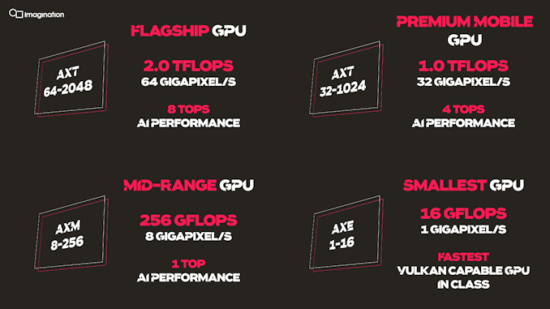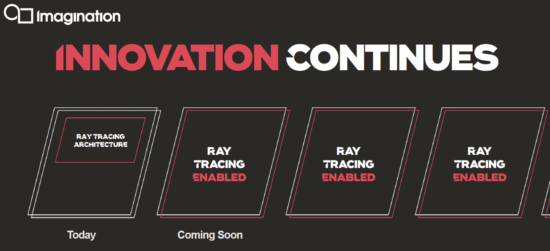The GPU of Everything and the fastest GPU IP.
Imagination Technologies announced the tenth generation of its PowerVR graphics architecture, the IMG A-Series. Claiming its IMG A-Series is the fastest GPU IP ever released, the company says it is designed to be The GPU of Everything, citing multiple markets, from automotive, AIoT, and computing through to DTV/STB/OTT, mobile and server.
The IMG A-Series has a multi-dimensional approach to performance scalability ranging from 1 pixel per clock (PPC) parts for the entry-level market up to 2 TFLOP cores for performance devices, and beyond that to multi-core solutions for cloud applications.
Imagination asserts that IMG A-Series delivers a significant improvement in every dimension, at the same clock and process, offering 2.5× the performance, 8× faster machine learning processing, and 60% lower power than current PowerVR devices shipping.

Imagination reports that customers have already licensed the IMG A-Series for multiple markets and the first SoC devices are expected in 2020.Compared to other GPU IP solutions available today, IMG A-Series delivers higher performance, lower power (compared to competitors at the same clock and process), claims the company, and lower bandwidth (at the same cache size as competitors) and all at a smaller silicon size. Its architecture also offers differentiators such as guaranteed 50% image compression data (lossless in most cases, or visually lossless in exception cases).
The IMG A-Series cores
IMG A-Series is available in four high-performance configurations:
- IMG AXT 64-2048 for flagship performance; 2.0 TFLOPS, 64 Gpixels, and 8 TOPS of AI performance
- IMG AXT 48-1536 for premium mobile; 1.5 TFLOPS, 48 Gpixels, and 6 TOPS
- IMG AXT 32-1024 for high-performance mobile and automotive; 1 TFLOPs, 32 Gpixels, and 4 TOPS
- IMG AXT 16-512 for high-mid-performance mobile and automotive; 0.5 TFLOPS, 16 Gpixels, and 2 TOPS
- IMG AXM 8-256 for mid-range mobile; 0.25 TFLOPS, 8 Gpixels, and 1 TOPS
For lower cost segments, the company is offering the IMG A-Series with the area, cost, and efficiency advantages:
- IMG AXE 2-16 for premium IoT, entry DTV/STB, display and other fillrate driven applications; 2 PPC, 16 GFLOPS, and 2 Gpixels
- IMG AXE 1-16 for entry-level mobile and IoT and the fastest Vulkan-capable GPU in its class; 1 PPC, 16 GFLOPS, and 1 Gpixels
The gamers GPU
Most mobile GPUs struggle to deliver consistent gaming experiences due to thermal constraints—they are fast for a short while, then slow to unacceptable levels and then never recover, resulting in a disappointing user experience. Imagination claims their IMG A-Series delivers sustained performance for extended gameplay at consistent frame rates avoiding thermal panic clock throttling, glitches, or overheating.
IMG A-Series’ PowerVR architecture has a bandwidth and power advantage due to its tile-based deferred rendering technology—it only draws what is visible on the screen. This is combined with advanced direct flexible power signaling using Pro-Active DVFS (Dynamic Voltage and Frequency Scaling) and Deadline Scheduling algorithms, which deliver fast power control with low latency response. If parts of the GPU aren’t fully utilized or needed for processing, they are immediately slowed down or even put to sleep to ensure optimal power efficiency.

One of the goals for the IMG A-Series is to deliver a great gaming experience for the user by delivering sustained stable framerates. This requires high GPU power efficiency, and this, says the company, is provided by PowerVR’s smart flexible firmware based low-latency DVFS algorithms with a direct GPIO control path into the system. All of this is combined with a strong focus on delivering visually impeccable pixels via features such as the visually lossless PVRIC compression and completely reworked anisotropic sampling and level of detail algorithms.
IMG A-Series is supported by Imagination’s toolset and SDK, offering new features, such as hardware-based tile heat maps, to help developers optimize their content.
HyperLane
The IMG A-Series also features Imagination’s HyperLane technology; individual hardware control lanes, each isolated in memory, enabling different tasks to be submitted to the GPU simultaneously for secure GPU multitasking. With dynamic performance control, the GPU can spread its performance across these multiple tasks, executing them all, while maximizing GPU utilization. Priority HyperLanes deliver a dynamic split, for example, prioritizing graphics and delivering all the required performance for that application while an AI task runs alongside using the remaining performance. HyperLane technology can also isolate protected content for rights management. All IMG A-Series GPUs support up to eight HyperLanes.
HyperLane also enables a new feature, AI Synergy. This new option enables SoC designers to take advantage of the various levels of compute capability in the IMG A-Series and accelerate AI workloads. Through AI Synergy, says Imagination, the GPU delivers graphics performance while using its spare resource to enable programmable AI alongside a fixed-function, highly optimized Imagination neural network accelerator. AI Synergy delivers programmable AI in the lowest silicon area, while a unified software stack enables flexibility and great performance.
IMG A-Series summary
- Very good performing GPU IP
- 2.5× performance density compared to the best current shipping PowerVR devices
- Scales for use in all GPU market segments
- Single-core options from 1 PPC to 2.0 TFLOPS
- High-performance density giving the best implementation cost for manufacturers and device price for consumers
- HyperLane Technology including support for multizone hardware virtualization technology delivering stability, security, and robustness
- Automotive options package with long-term support, ISO 26262 certification readiness, and documentation
- PVRIC4.1 lossless or visually lossless image compression, guaranteeing 50% bandwidth and footprint reduction all the time
- Advanced flexible direct power control technology
- Unified AI API for use in combination with PowerVR neural network accelerators
- Supports the latest API standards including OpenGL ES, Vulkan, OpenCL
What do we think?
The simple fact is that for mobile SoCs, the market leader owns its own GPU technology and is increasing market share at the rate of 5% year-on-year. In order to stop the losses to their own potential share, the other mobile SoC companies need a compelling GPU that will deliver some real competition. Imagination’s A-Series can do that.





